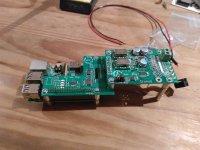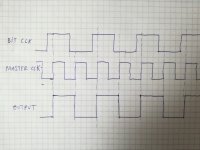Already done - just testing (probably today)
Awesome!!!
Already done - just testing (probably today)
Great news! What will it need in the way of drivers? I'm not that capable in the land of ssh. One of the great things about the Pi is that its easy to get a digital file player going without a lot of code wrangling.
I hope Russ won't mind if I answer this question. 
Driver will be a standard overlay (like hifiberry and others)
First tests will be on a custom Libreelec build and if everything is right, a patch will be proposed to the Raspberry Pi kernel maintainers.
To enable it, you will need to wait for the upgraded kernel in your prefered distribution, then to set the overlay in the config.txt file on your rpi.
For distribution like Volumio where everything is done by GUI, it will need time for them to upgrade their kernel and add this overlay option.
So... Patience is a virtue
Driver will be a standard overlay (like hifiberry and others)
First tests will be on a custom Libreelec build and if everything is right, a patch will be proposed to the Raspberry Pi kernel maintainers.
To enable it, you will need to wait for the upgraded kernel in your prefered distribution, then to set the overlay in the config.txt file on your rpi.
For distribution like Volumio where everything is done by GUI, it will need time for them to upgrade their kernel and add this overlay option.
So... Patience is a virtue
Very glad you joined in! Thanks for answering!I hope Russ won't mind if I answer this question.
Just to keep RPi lovers posted, I just tested the Hermes-RPi card today.
Tried it with a patched Libreelec distribution.
Perfect on all sample rates
44.1 - 48 - 88.2 - 96 - 176.8 - 192 - 352.8 - 384 are all ok.
Gapless between tracks having the same sample rate.
I love it...
Well, it's time to patch the official kernel...
It may take a week or two before submiting to github.
(Remember, Cronus - it's a matter of time)
Good job Russ & Brian!
I'm happy
(About the picture, yes, cronus should have been under the hermes. But I already had soldered it that way...)
Tried it with a patched Libreelec distribution.
Perfect on all sample rates
44.1 - 48 - 88.2 - 96 - 176.8 - 192 - 352.8 - 384 are all ok.
Gapless between tracks having the same sample rate.
I love it...
Well, it's time to patch the official kernel...
It may take a week or two before submiting to github.
(Remember, Cronus - it's a matter of time)
Good job Russ & Brian!
I'm happy
(About the picture, yes, cronus should have been under the hermes. But I already had soldered it that way...)
Attachments
Last edited:
Thank you for your help and testing as well!Good job Russ & Brian!
I'm happy
I am really glad to hear it is working as designed!
Now users have more choices. Amanero, BBB, Rpi
With Buffalo III SE Pro (ES9028/38) you could even stream DSD (up to DSD256) via DoP from the Rpi since it decodes DoP.
Cheers!
Russ
Just to keep RPi lovers posted, I just tested the Hermes-RPi card today.
Tried it with a patched Libreelec distribution.
Perfect on all sample rates
44.1 - 48 - 88.2 - 96 - 176.8 - 192 - 352.8 - 384 are all ok.
Gapless between tracks having the same sample rate.
I love it...
Well, it's time to patch the official kernel...
It may take a week or two before submiting to github.
(Remember, Cronus - it's a matter of time)
Good job Russ & Brian!
I'm happy
(About the picture, yes, cronus should have been under the hermes. But I already had soldered it that way...)
Nice. I already have Rpi3 -> hifiberry digi+ pro -> I2S -> es9038q2m working like that using Volumio
Great job guys! Thanks!
As the RPi's top pcm sample rate is 352.8/384 kHz, you should be limited to DSD128 max via DoP.With Buffalo III SE Pro (ES9028/38) you could even stream DSD (up to DSD256) via DoP from the Rpi since it decodes DoP.
DSD256 requires twice this frequency if I'm not mistaken.
Last edited by a moderator:
As the RPi's top pcm sample rate is 352.8/384 kHz, you should be limited to DSD128 max via DoP.
DSD256 requires twice this frequency if I'm not mistaken.
You are correct - I just meant that the ES9028 itself could do up to DSD256 via DoP if you can feed it equivalent 768kHz PCM
The rPI looks like it will only go up to DSD128 because of the bit clock timing restrictions - still... I wonder if one could push the envelope
Well, based on this benchmark, a RPi 2 or 3 "may" handle 45/49 MHz rate on GPIOs.
Raspberry Pi 2 vs. 1 GPIO Benchmark – Code and Life
It should requires a modified kernel, 90/98 clocks on the cronus and...
To change the driver for Hermes-RPi as it is specified with 22/24 masterclock input in mind
Let's settle with what is working fine first
Raspberry Pi 2 vs. 1 GPIO Benchmark – Code and Life
It should requires a modified kernel, 90/98 clocks on the cronus and...
To change the driver for Hermes-RPi as it is specified with 22/24 masterclock input in mind
Let's settle with what is working fine first
Already done - just testing (probably today)
This board is exactly what I'am looking for, well almost...what about isolating I2C as well, so we could make rpi controller for es9038 as well, that would be great.
regards
Tomasz
This board is exactly what I'am looking for, well almost...what about isolating I2C as well, so we could make rpi controller for es9038 as well, that would be great.
regards
Tomasz
Look closely - it already has isolated i2c
Look closely - it already has isolated i2c
wow, this is how profi works, how could i even doubt....i think i shall just lean back and order the things
Divider is provided there, because some sources claims that there is maximum supported frequency they can process. so you can use 100MHz clock and divide it to 50 if 25MHz for the source if needed.
Double frequency for re-clocking is needed because signal is delayed by half period of the (audio) bit clock.
Double frequency for re-clocking is needed because signal is delayed by half period of the (audio) bit clock.
The reclocking is done on each rising egde from the master clock (when going from 0 to 1)Hello guys,
Could you please explain me why the re-clocking must be done with a frequency at least twice higher that the one feed to the BBB?
What is the advantage to use 1:2 divider instead of 1:1 ?
Thank you !
So you need 2 rising edges to map the 0 and 1 of the fastest bitclock.
(Or 4 on this exemple)
Attachments
Last edited:
The reclocking is done on each rising egde from the master clock (when going from 0 to 1)
So you need 2 rising edges to map the 0 and 1 of the fastest bitclock.
(Or 4 on this exemple)
So let me know if I understand right: because the bit clock is delayed compared to the master clock (it will travel through the BBB in my case and then to the Cronus) the flip flop will miss the rising edge of the first high master clock and only be trigger on the next high master clock - from here it appears the half period delay that miero talked about?
If this is right then using a 2X master clock freq the signals will still be delayed compared to the original one but if they all pass through the flip flop they all be sinq and the audio quality will not be damage at all from the delay?
I drew how the signals would be if the master clock is twice the fastest bit clock, the result is similar with the one from grael with four times fastest, so it will be no advantange to use 4x over 2x?
Thank you !
Attachments
Hi,
I think I cover this is the first couple of posts.
Yes - the whole purpose of the FF is to finally (at the output of the cronus) time align all of the signals to the master clock. That is the actual master clock - not a divided clock.
The source it self may be synced to an isolated version of the master clock (which will not be exactly in phase) either 1:1 or divided 1:2 or 1:4.
The net result is - all combined phase errors (source + isolation) are ultimately eliminated by the FF. When time aligning a signal to a master clock using a FF the maximum input rate of the signal can only be half the rate of the master clock. This is a rule for all FFs - it is not a case that is special to the Cronus.
Cheers!
Russ
I think I cover this is the first couple of posts.
Yes - the whole purpose of the FF is to finally (at the output of the cronus) time align all of the signals to the master clock. That is the actual master clock - not a divided clock.
The source it self may be synced to an isolated version of the master clock (which will not be exactly in phase) either 1:1 or divided 1:2 or 1:4.
The net result is - all combined phase errors (source + isolation) are ultimately eliminated by the FF. When time aligning a signal to a master clock using a FF the maximum input rate of the signal can only be half the rate of the master clock. This is a rule for all FFs - it is not a case that is special to the Cronus.
Cheers!
Russ
Last edited:
Hi,
Looking for some troubleshooting help. I have just assembled a B3SEPro / Mercury combo. Hooking up via SPDIF the DAC will lock.
When adding the Amanaro / Hermes / Cronus, and switching switch 1, position 1 to off, I get no lock on the DAC.
The MacBook feeding the Amanero shows the Amanero as connected and set as the output device.
The divider is set to 2:1, power is good at 5V, I have checked and double checked all wiring. Any clues as to how to troubleshoot this?
Thanks in advance.
Martin
Looking for some troubleshooting help. I have just assembled a B3SEPro / Mercury combo. Hooking up via SPDIF the DAC will lock.
When adding the Amanaro / Hermes / Cronus, and switching switch 1, position 1 to off, I get no lock on the DAC.
The MacBook feeding the Amanero shows the Amanero as connected and set as the output device.
The divider is set to 2:1, power is good at 5V, I have checked and double checked all wiring. Any clues as to how to troubleshoot this?
Thanks in advance.
Martin
- Home
- More Vendors...
- Twisted Pear
- Cronus - It's about time.



